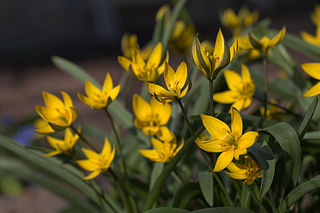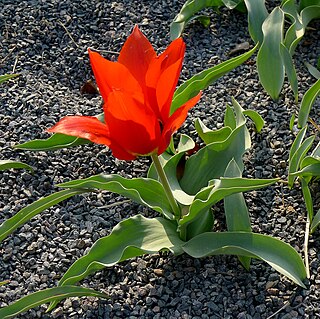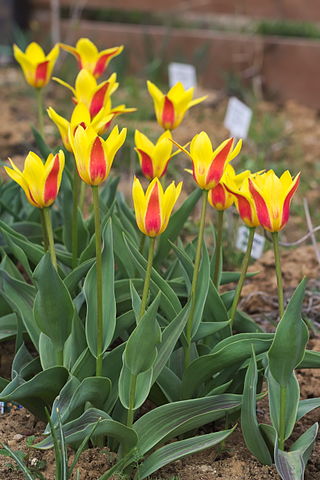
Tulipa gesneriana, the Didier's tulip or garden tulip, is a species of plant in the lily family, cultivated as an ornamental in many countries because of its large, showy flowers. This tall, late-blooming species has a single blooming flower and linear or broadly lanceolate leaves. This is a complex hybridized neo-species, and can also be called Tulipa × gesneriana. Most of the cultivars of tulip are derived from Tulipa gesneriana. It has become naturalised in parts of central and southern Europe and scattered locations in North America.

Tulips are spring-blooming perennial herbaceous bulbiferous geophytes in the Tulipa genus. Their flowers are usually large, showy, and brightly coloured, generally red, orange, pink, yellow, or white. They often have a different coloured blotch at the base of the tepals, internally. Because of a degree of variability within the populations and a long history of cultivation, classification has been complex and controversial. The tulip is a member of the lily family, Liliaceae, along with 14 other genera, where it is most closely related to Amana, Erythronium, and Gagea in the tribe Lilieae.

Tulipa armena is a species of flowering plant in the Liliaceae family. It is referred to by the common name Armenian tulip, and is native to the historical Armenian Highlands as the name implies; current regions of Armenia, modern day Turkey, Iran, South Caucasus, and Azerbaijan.

Tulipa sprengeri, or Sprenger's tulip, is a wild tulip from the Pontic coast of Turkey. It is quite rare and possibly extinct in the wild, but widely cultivated as an ornamental.
Allium kurssanovii is a species of wild onion native to Central Asia. It grows on cliff faces and other sun-lit locations at elevations of 2200–2700 m.
Allium platyspathum is an Asian species of wild onion. It has been reported from Xinjiang, Afghanistan, Kazakhstan, Kyrgyzstan, Mongolia, Altay Krai, Tajikistan, Uzbekistan, and Pakistan. It grows in damp locations at elevations of 1900–3700 m.
Allium schoenoprasoides is an Asian species of wild onion native to Xinjiang, Kazakhstan, Kyrgyzstan and Tajikistan. It can be found at elevations of 2700–3000 m.

Allium winklerianum is an Asian species of onion native to Xinjiang, Afghanistan, Tajikistan, Uzbekistan, Kyrgyzstan, and Tajikistan. It is also cultivated as an ornamental elsewhere because of the pretty flowers and also because of the strong lilac scent to the blooms.
Allium filidens is a species of onion found at high elevations of central and south-central Asia. It is a bulb-forming perennial up to 45 cm tall, forming a hemispherical umbel of flowers; tepals white or pink with a purple midvein.

Tulipa suaveolens, synonym Tulipa schrenkii, the van Thol tulip or Schrenck's tulip, is a bulbous herbaceous perennial of species of tulip (Tulipa) in the family of the Liliaceae. It belongs to the section Tulipa. It is the probable wild ancestor of the garden tulip.

Tulipa dasystemon, synonym Tulipa neustruevae, is a bulbous herbaceous perennial species of tulip (Tulipa) in the family Liliaceae. It belongs to the section Biflores.
Tulipa aleppensis is a wild tulip in the family Liliaceae. It is native to Southeastern Turkey, Syria, near Beirut in Lebanon.

Gagea alberti is an Asian species of plants in the lily family, native to Kazakhstan, Kyrgyzstan and Xinjiang Province of western China.

Gagea bulbifera is a Eurasian species of plants in the lily family, widespread from Romania to Xinjiang. It is native to Romania, Russia, South Caucasus, Kazakhstan, Kyrgyzstan, Iran, Turkey, Xinjiang, Western Himalayas.
Gagea divaricata is an Asian species of plants in the lily family, native to Kazakhstan, Kyrgyzstan, Tajikistan, Uzbekistan, and Xinjiang Province of western China.
Gagea olgae is an Asian species of plants in the lily family. It is native to Iran, Pakistan, Afghanistan, Kyrgyzstan, Tajikistan, Uzbekistan, Kazakhstan, and Xinjiang.

Tulipa eichleri, commonly known as Eichler tulip or Eichler's tulip, is a species of tulip. It is a bulbous flowering perennial with long green leaves,deep red flowers with a central black blotch, coming from the Caucasus Mountains.

Tulipa alberti, or Albert's tulip, is a species of flowering plant in the family Liliaceae. It has long reddish, orange or pink flowers. It comes from the mountains of Central Asia.

Tulipa kaufmanniana, the water lily tulip, is a species of tulip native to Central Asia.

Tulipa praestans is a species of tulip native to the mountains of Tajikistan. Many well known cultivars have been formed from the original plant.















